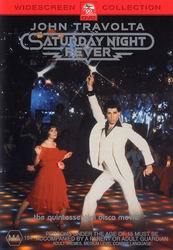Saturday Night Fever (1977) |
|
Saturday Night Fever (1977) |
|


|
| BUY IT |
| General | Extras | ||
| Category | Drama |
Main Menu Introduction Main Menu Audio & Animation Audio Commentary-John Badham (Director) Featurette-Highlights From VH1's Behind The Music Deleted Scenes-3 |
|
| Rating |

|
||
| Year Of Production | 1977 | ||
| Running Time | 114:08 | ||
| RSDL / Flipper | RSDL (77:57) | Cast & Crew | |
| Start Up | Menu | ||
| Region Coding | 4 | Directed By | John Badham |
|
Studio
Distributor |
 Paramount Home Entertainment |
Starring |
John Travolta Karen Lynn Gorney Donna Pescow |
| Case | Amaray-Opaque | ||
| RPI | $31.95 | Music |
Bee Gees David Shire |
| Video | Audio | ||
| Pan & Scan/Full Frame | None |
English Dolby Digital 5.1 (448Kb/s) English Audio Commentary Dolby Digital 2.0 |
|
| Widescreen Aspect Ratio | 1.78:1 | ||
| 16x9 Enhancement |
 |
||
| Video Format | 576i (PAL) | ||
| Original Aspect Ratio | 1.85:1 | Miscellaneous | |
| Jacket Pictures | No | ||
| Subtitles |
Greek English Hebrew Croatian Portuguese Slovenian English Audio Commentary |
Smoking | Yes |
| Annoying Product Placement | No | ||
| Action In or After Credits | No | ||
Saturday Night Fever is a classic movie and a great DVD.
In the late 1970s, two modern American film classics were produced, Rocky and Saturday Night Fever. Both remain as poignant and as enthralling today, as when they were originally released. Both contain memorable stories, characters, and moments that we find burned into our collective consciousness.
Saturday Night Fever was inspired by Nik Cohn's magazine article, entitled Tribal Rites Of The New Saturday Night. It was an exploration of a New York sub-culture, in which young, blue-collar workers, looking for an identity, left their ordinary lives behind to live extraordinary lives on the dance floors of New York discos. Barry Gibb claims that he thought of the movie's new title, and that when he told the movie's producer, Australian music guru, Robert Stigwood, Stigwood rejected his suggestion, saying that "it sounded like a porno!" The movie is largely set on the sleazy streets of Brooklyn, where the urban characters and gritty city come alive at night. The subterranean discos offer an escape from the drudgery of life - a mystical land of flashing lights and pulsating music. By day, Tony (John Travolta), works as a "nobody" in a hardware store, but by night, he is the king of the disco dance floor. Tony lives life with no thought for the future, he hangs out with his pals, and they all live from one Saturday night to the next. Tony and his friends also have trouble communicating and relating to women, outside of sex. That all begins to change when Tony swaps his long-suffering dance partner, Annette (Donna Pescow), for the ambitious Stephanie (Karen Lynn Gorney). Presented with a new role model, Tony begins to question his life and his future.
Just as the movie Rocky was not about boxing, but used boxing as a metaphor, Saturday Night Fever remains the quintessential disco dance movie, yet it's not about dancing. It's a love story, but it's not really about love either. At the core of this movie, is a dark story about people being trapped by culture and ignorance. It's about disillusionment, and falling short of one's dreams. It's about the Brooklyn Bridge, which appears as a metaphor throughout the movie. The bridge connects two vastly different worlds: The upper-class and sophisticated Manhattan, and the urban working-class Brooklyn. The movie is about two characters' attempt to cross that bridge, not only physically, but mentally, and make a better life for themselves.
Saturday Night Fever boasts brilliant acting, superb direction, great dancing, and electrifying music. The cinematography by Ralf D Bode is simply magnificent - who can forget the opening scene of Tony strutting down a Brooklyn street to the hypnotic beat of the Bee Gees? Saturday Night Fever remains a pop-culture icon, as it pushed disco, and disco music, into the mainstream. In doing so, it ushered in new fashion, new music, and new moves on the dance floor. While the movie captures the wide collar shirts, hairy chests, gold chains, bell-bottomed pants, platform shoes, tight polyester suits, and big afros of the late 1970s, there is an eternal truth to the story. This movie is about as good as filmmaking can get.
The transfer is very grainy, but overall I was very impressed, considering the age of the source material.
The transfer is presented in an aspect ratio of 1.78:1, 16x9 enhanced. This is not the original theatrical aspect ratio, but it is close.
The sharpness of the image is reasonable, but the shadow detail is poor. Indeed, in dark scenes it's dreadful, such as the street scene at 54:40.
The quality of the colour is variable. While it tends to be a little dark at times, it is mostly well-saturated.
There were no distracting problems with MPEG artefacts.
Film-to-video artefacts appeared in the form of very mild aliasing, such as the shimmer on the car windscreen at 66:05.
Film artefacts appear throughout, but they are mostly tiny. I never found them distracting.
While it is never a problem, there appears to be some slight edge enhancement at times, such as at 52:51.
There are seven sets of subtitles present. The English subtitles are a simplified, but accurate, reflection of the dialogue.
This is a RSDL disc, with the layer change placed at 77:57. It is noticeable, but not disruptive.
| Sharpness | |
| Shadow Detail | |
| Colour | |
| Grain/Pixelization | |
| Film-To-Video Artefacts | |
| Film Artefacts | |
| Overall |
Originally released theatrically in Dolby Stereo, the audio has been remixed into Dolby Digital 5.1 for this DVD.
Apart from the default English Dolby Digital 5.1 audio track, there is a Dolby Stereo-Surround track for the director's commentary.
The dialogue quality and audio sync are generally very good, but there are a few moments when the audio sync seems to slip, such as at 55:56.
The musical score is credited to the Bee Gees, with some additional music by David Shire. Not only does this movie boast the all-time biggest selling movie soundtrack, but until Michael Jackson's Thriller, this was the all-time best-selling music album. The music is integral to the story, and the movie is often described as being a musical. The movie's soundtrack includes such memorable songs as If I Can't Have You, How Deep Is Your Love, Night Fever, Staying Alive, More Than A Woman, Disco Inferno, You Should Be Dancing, and Boogie Shoes.
Considering the movie's stereo origins, I was surprised by the level of surround presence and activity. While the surround sound mix is quite front-heavy, the rear speakers are used effectively to help carry the score and provide ambience, such as the New York traffic at 54:23. This maintains a nice soundfield while keeping the viewer firmly focussed on the screen.
The subwoofer adds some support to the score, but it never really draws attention to itself.
| Dialogue | |
| Audio Sync | |
| Clicks/Pops/Dropouts | |
| Surround Channel Use | |
| Subwoofer | |
| Overall |
This is what I like - quality, not quantity!
An animated menu, presented in an aspect ratio of 1.78:1, 16x9 enhanced, with Dolby Digital stereo audio.
Director's Commentary
John Badham provides a great commentary track, filled with many insights and interesting trivia.
Highlights from VH1's Behind The Music (30:44)
Presented in an aspect ratio of 1.33:1, with Dolby Digital stereo audio, this is a genuine and fascinating documentary.
Deleted Scenes
Three scenes presented in an aspect ratio of 1.78:1, 16x9 enhanced, with Dolby Digital stereo audio.
NOTE: To view non-R4 releases, your equipment needs to be multi-zone compatible and usually also NTSC compatible.
Saturday Night Fever was released on DVD in Region 1 on 8 October 2002.
The Region 4 DVD misses out on:
The Region 1 DVD misses out on:
I would favour the local release for its affordability, and most importantly, its superior PAL image.
Saturday Night Fever is a sensational modern movie classic, on a great DVD.
The video quality is good, considering the age of the source material.
The audio quality is also good.
The extras are genuine, and really do add to one's enjoyment of the movie.
| Video | |
| Audio | |
| Extras | |
| Plot | |
| Overall |
| Review Equipment | |
| DVD | Pioneer DV-535, using S-Video output |
| Display | Grundig Elegance 82-2101 (82cm, 16x9). Calibrated with Video Essentials. This display device is 16x9 capable. |
| Audio Decoder | Built in to amplifier/receiver. Calibrated with Video Essentials. |
| Amplification | Sony STR DE-545 |
| Speakers | Sony SS-V315 x5; Sony SA-WMS315 subwoofer |